New premium Gulf airline Riyadh Air, which launches later this year, has revealed the cabin product for its Boeing 787 aircraft. They frame the product choice and cabin interior design as “setting new levels of comfort and entertainment.”
The Riyadh Air Boeing 787-9 will hold up to 290 passengers:
- 4 Business Elite
- 24 Business
- 39 Premium economy
- 223 Economy
According to Riyadh Air CEO Tony Douglas,
Riyadh Air has always promised to deliver a world- class experience for our guests and the unveiling of our cabin interiors make this ambition a reality. The design, layout, and features of our new cabins are carefully crafted to ensure flights are as comfortable and enjoyable as possible. From the ergonomic and luxurious fabrics in the seats to the high-end technology used in the entertainment systems, every facet of the cabins has been chosen to deliver relaxing luxury.
One Of The World’s Best Business Class Seats
Riyadh Air will feature the Safran Unity seat, which first debuted on Japan Airlines A350-1000s. That seat has been chose for Air India’s refresh and the new Qantas A350.
These will be enhanced with high-end finishes that CEO Tony Douglas has described as like the difference between a Merc S Class and a Maybach, a much nicer fit out even using a top shelf but standard seat.
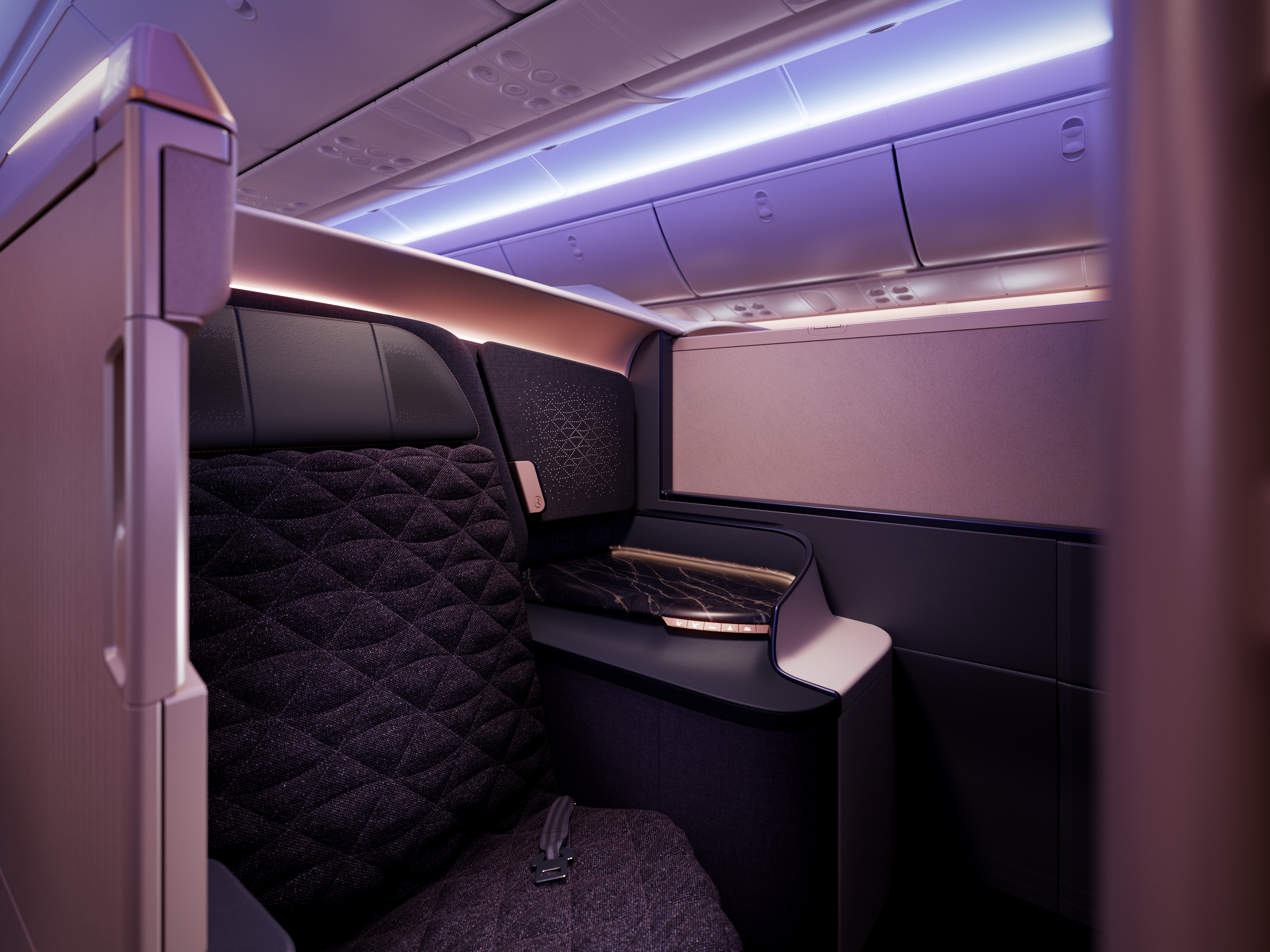
Credit: Riyadh Air
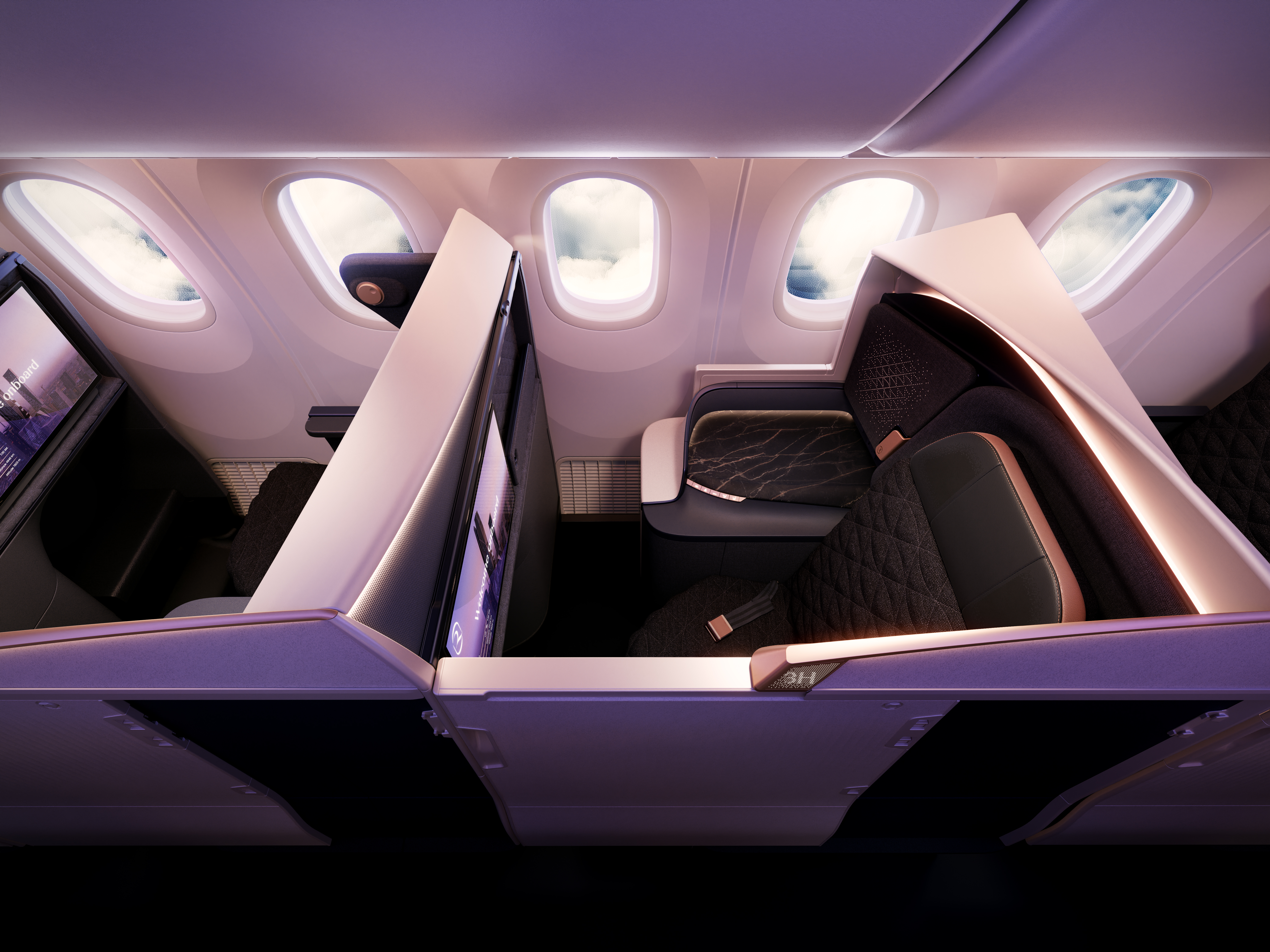
Credit: Riyadh Air
Layout will be 1-2-1 (the Unity seat is a staggered seat). The flat bed length will measure 78 inches and the seat is 22.5 inches wide. The seat will have 52-inch-high walls and sliding doors. Center seats will have adjustable privacy dividers.
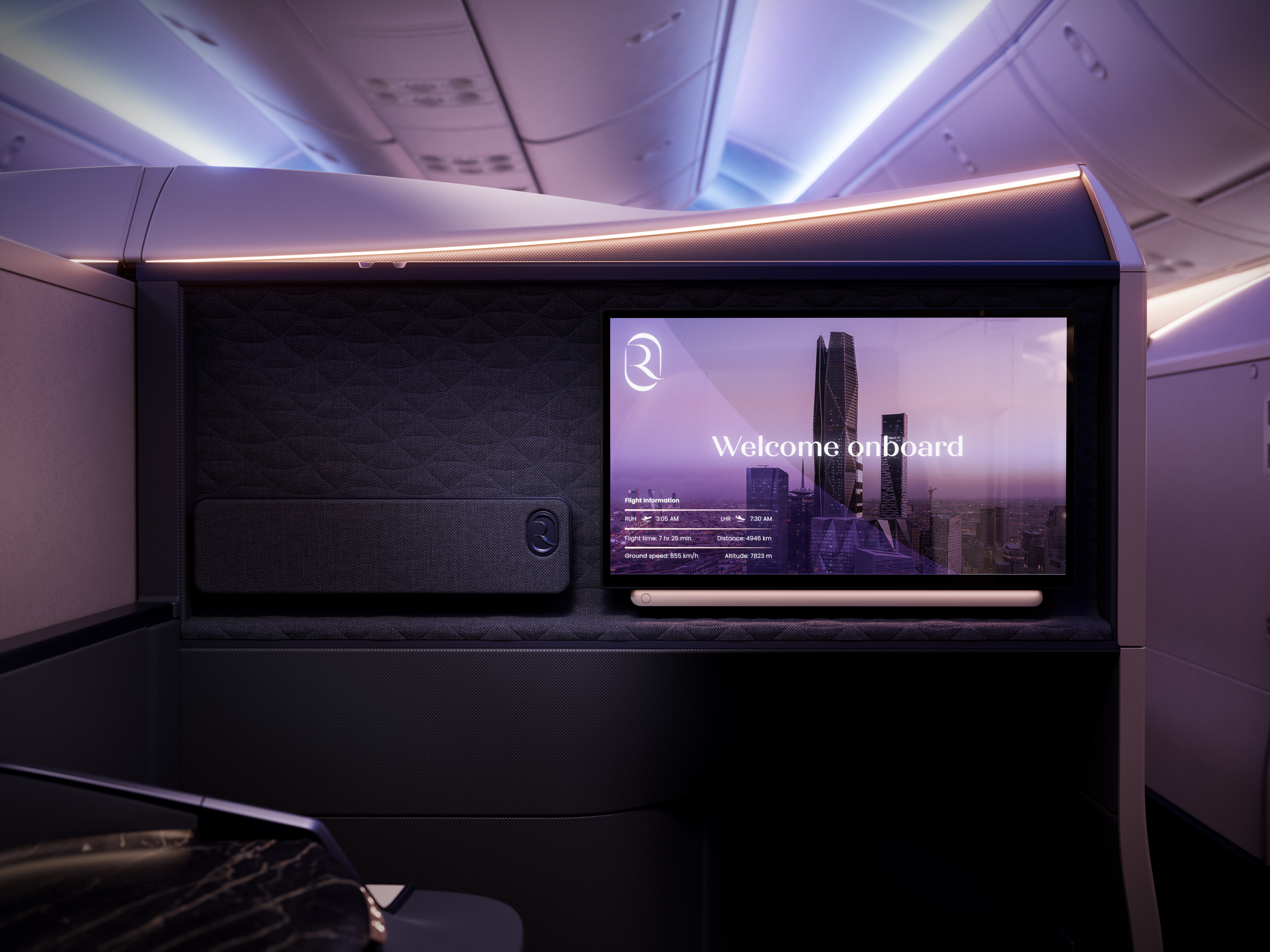
Credit: Riyadh Air
TVs will be 22″ 4K OLED touchscreens. Seats will feature embedded speakers developed in a sound collaboration with French acoustic technology company Devialet to provide “immersive, high-fidelity sound without the need for headphones.” And there will be A/C power and two USB-C and one USB- A ports for charging.
A Class Above Business Class – But Not True First Class, Yet
Riyadh Air will be placing another widebody order this year. That aircraft will feature a true first class. For the 787 they have a front row business class that’s extra spacious and with additional amenities that is sold as a separate cabin and branded Business Extra. This is to avoid confusion with first class which will be a further elevated experience.
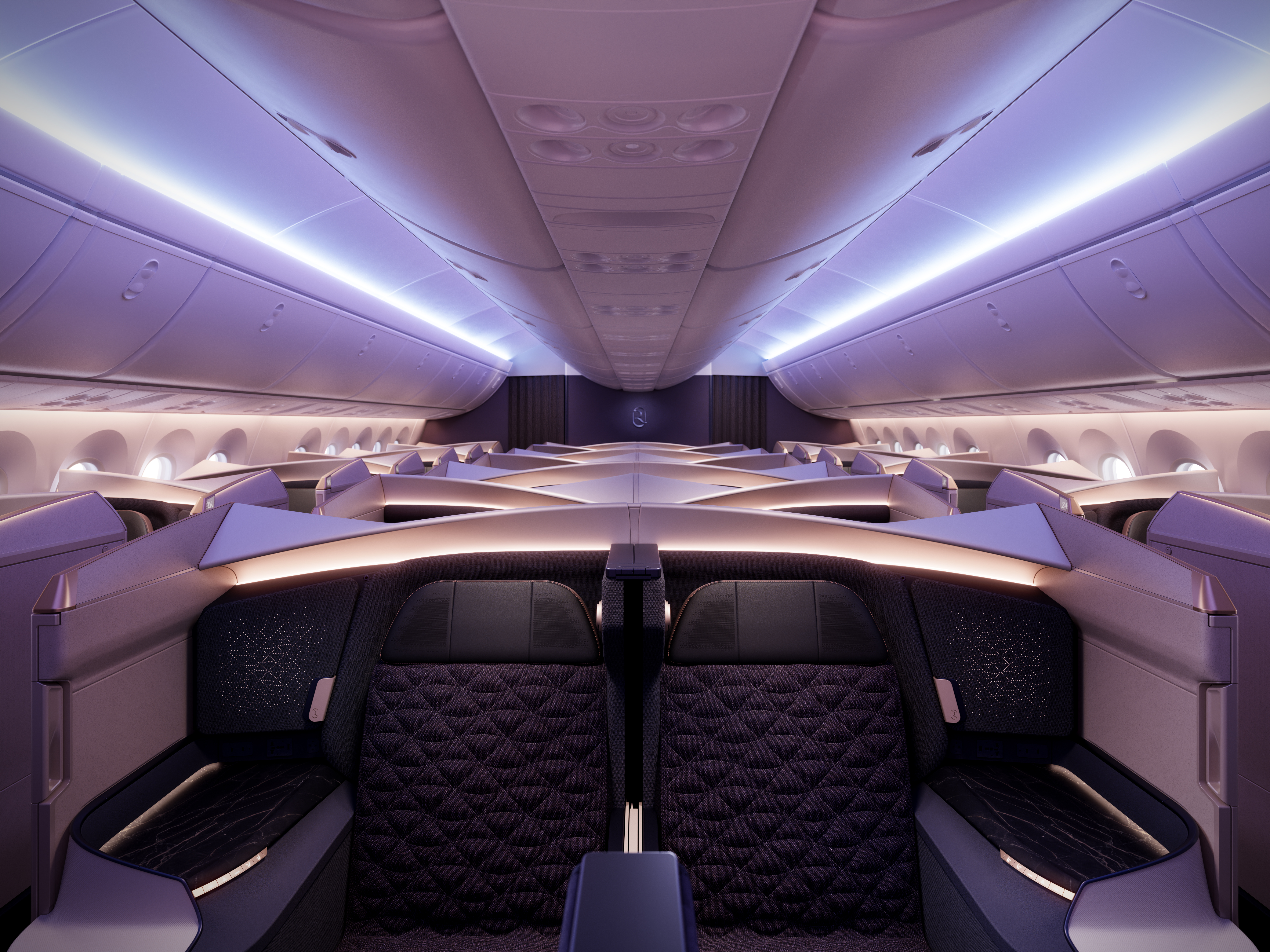
Credit: Riyadh Air
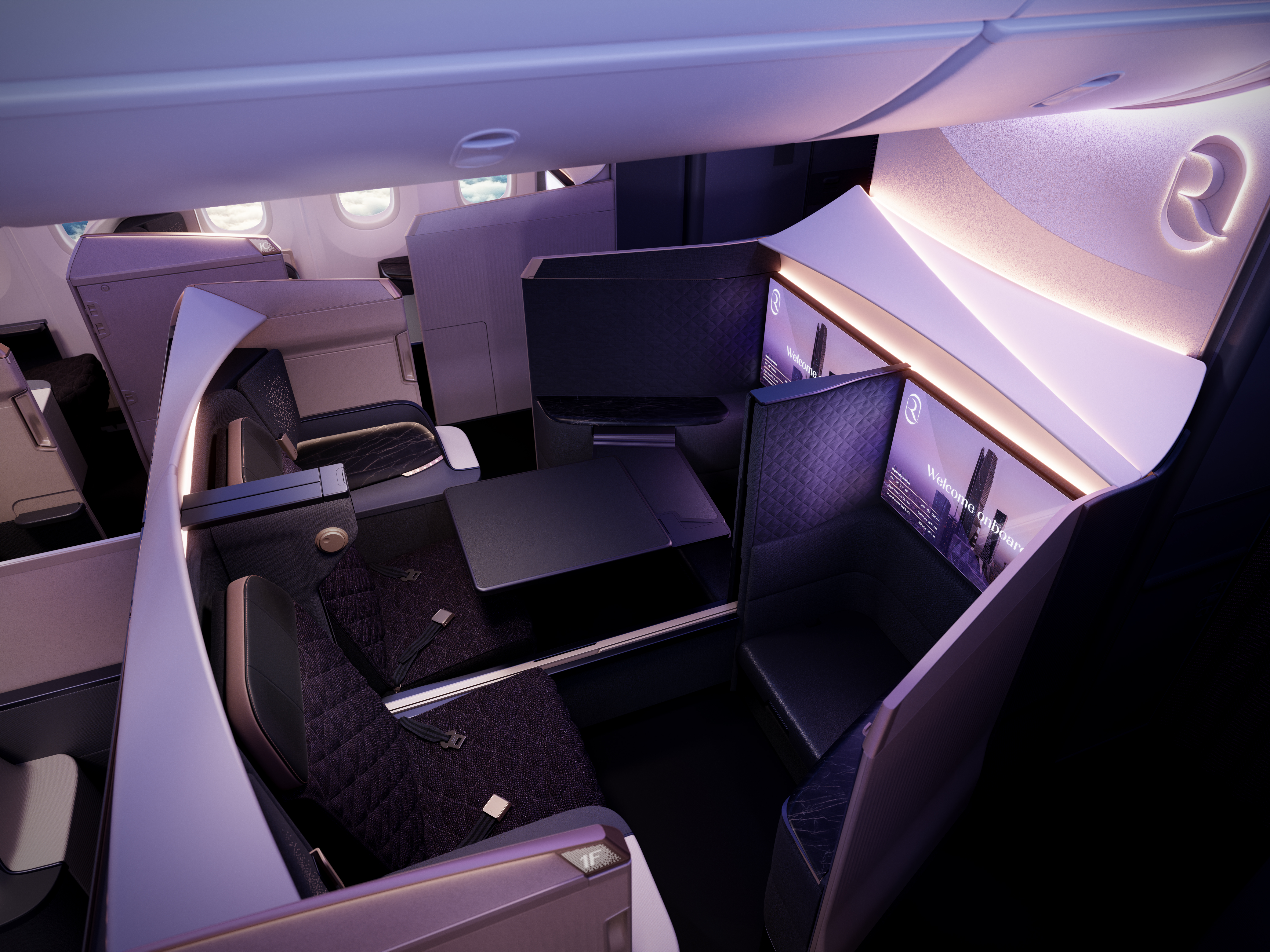
Credit: Riyadh Air
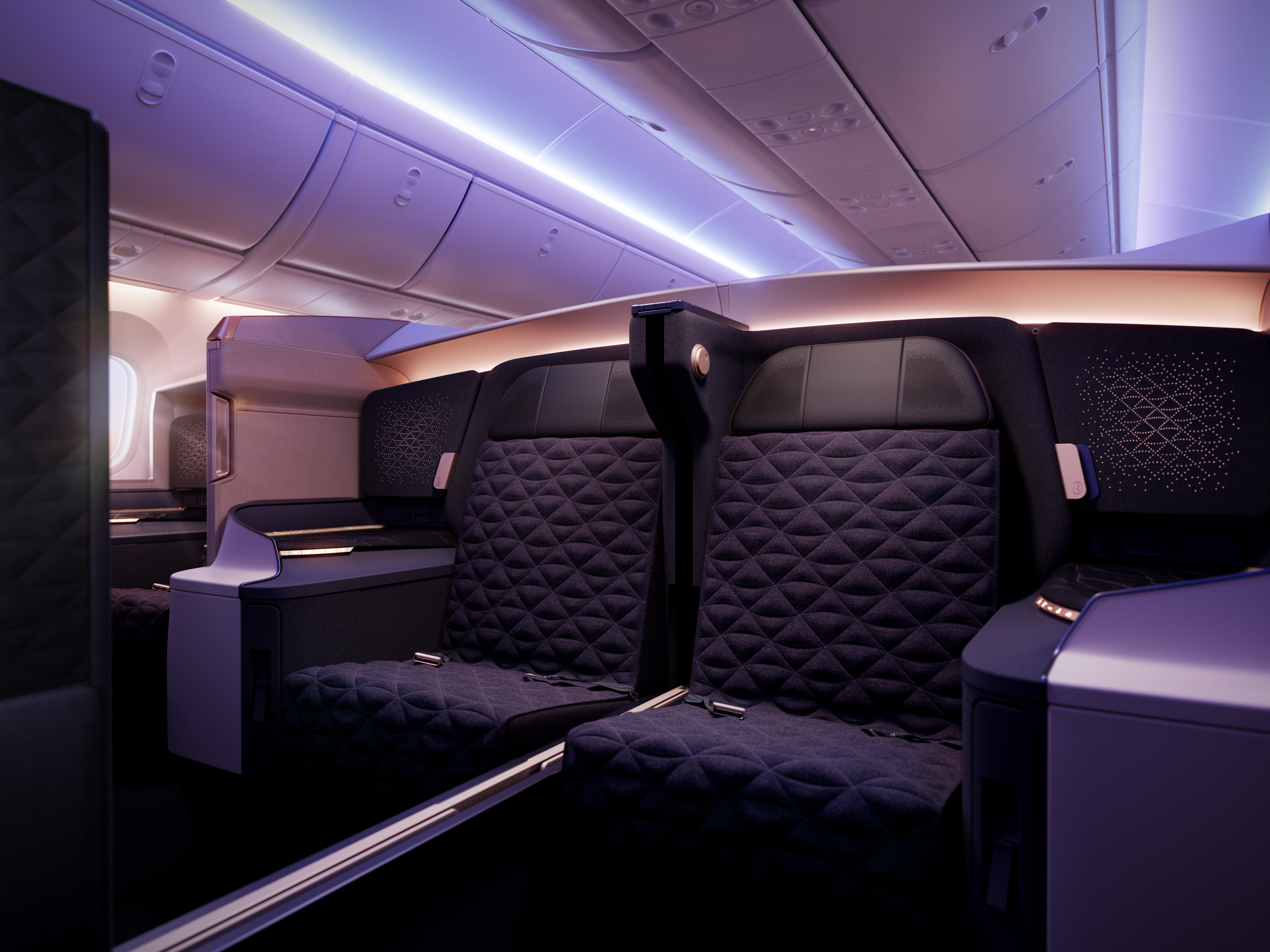
Credit: Riyadh Air
There will be one row of Business Elite on their 787s, like business class in a 1-2-1 configuration. These seats will offer 32-inch screens and center seats will provide double beds for passengers traveling together.
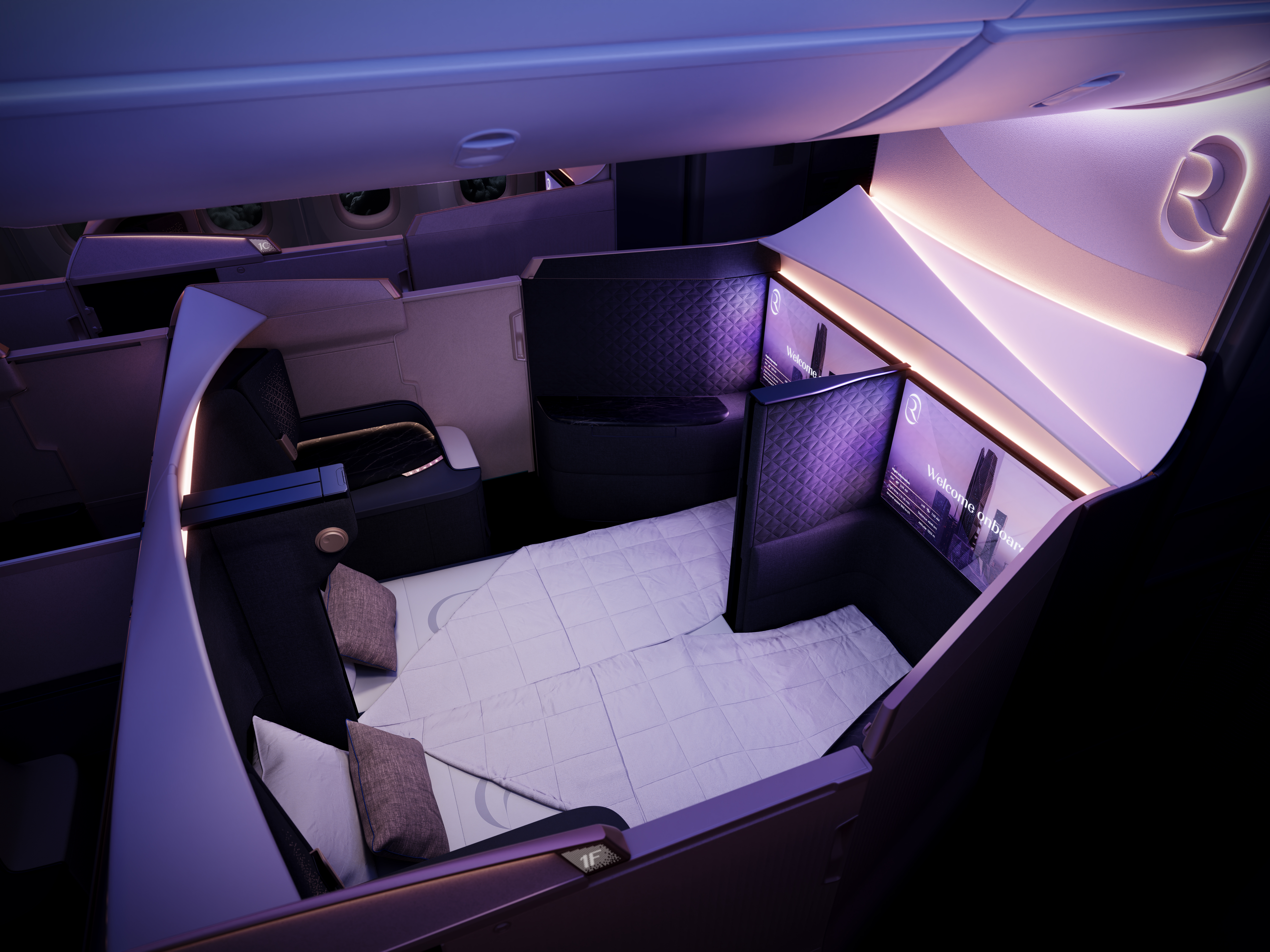
Credit: Riyadh Air
Premium Economy
Premium Economy will offer a standard Boeing 787 layout of 2-3-2, 38 inch seat pitch and 19.2 inch width. It will feature the same Mocha Gold metallic scheme as higher premium cabins, and 15.6” 4K OLED touchscreen TVs as well as privacy head wings; increased seat storage; expandable side table; calf rest and 4 USB-C charge ports.
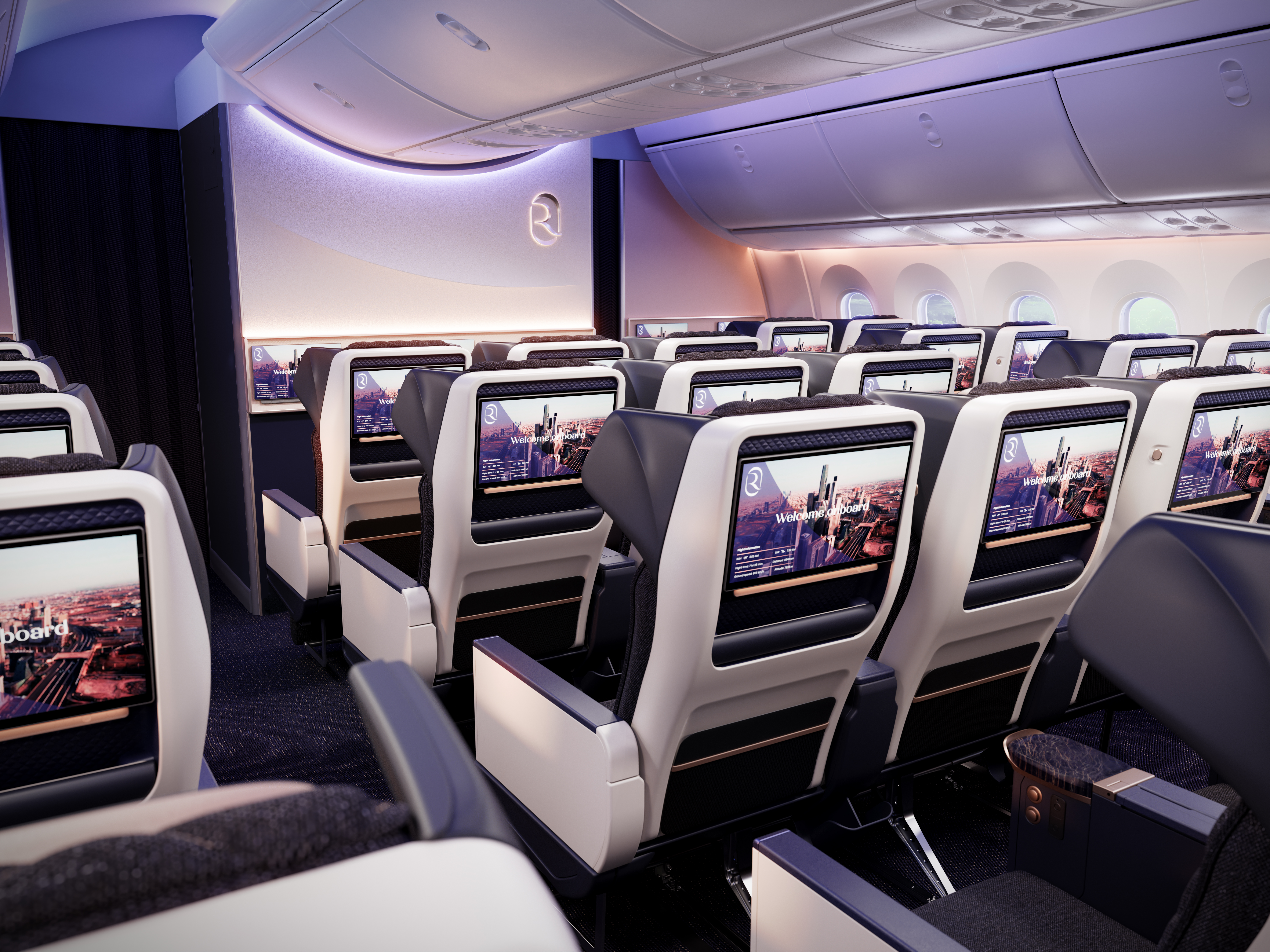
Credit: Riyadh Air
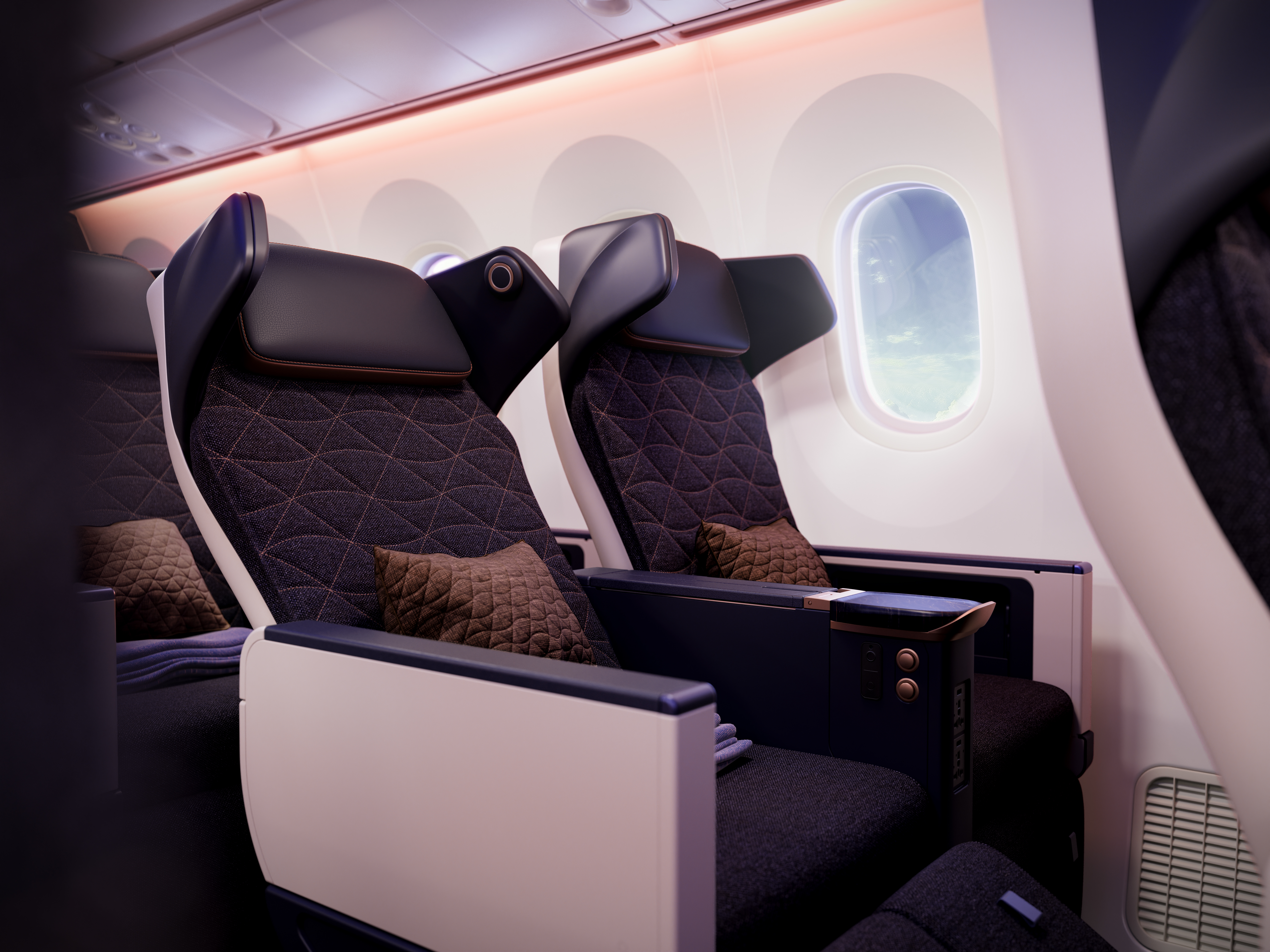
Credit: Riyadh Air
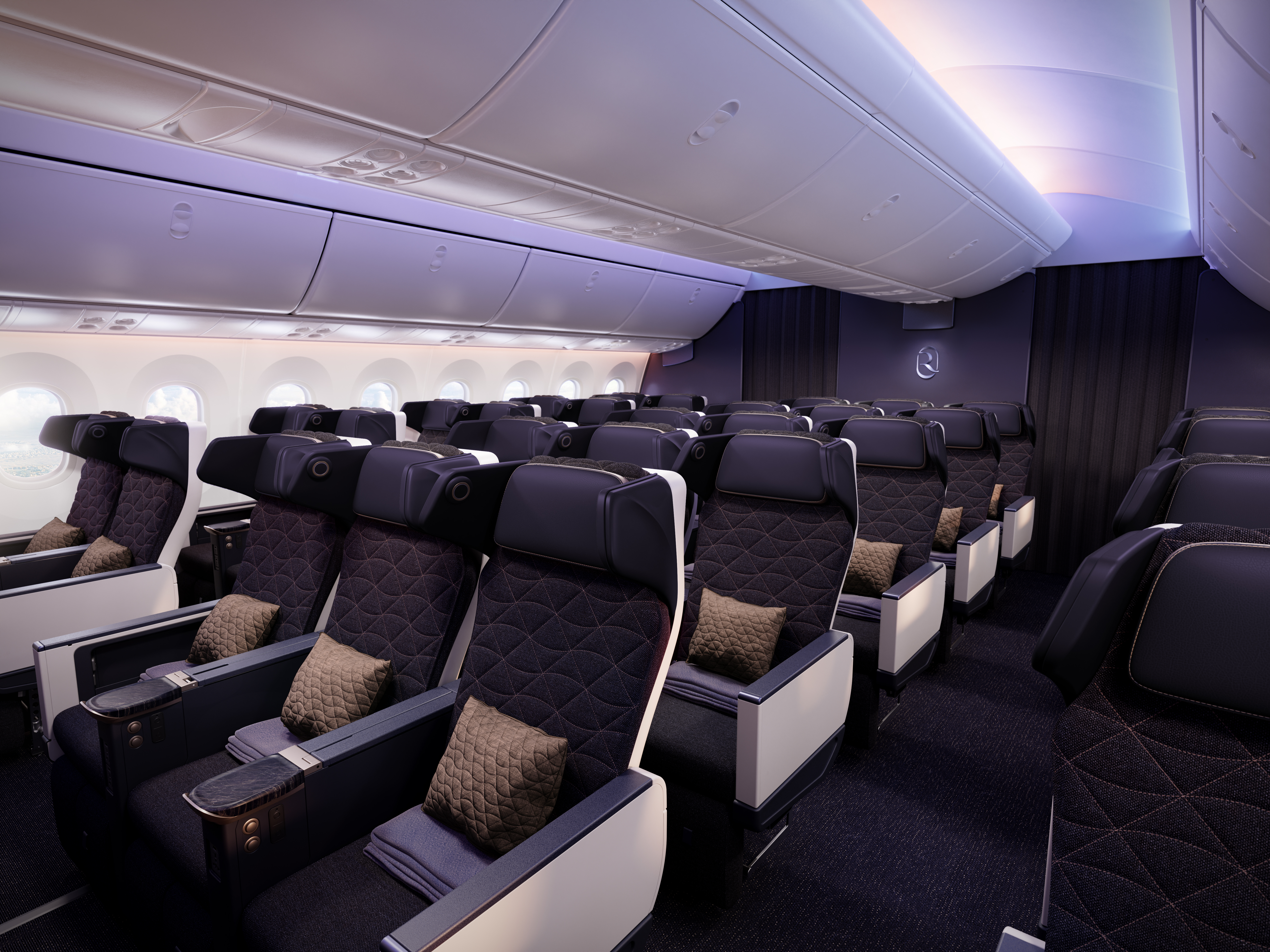
Credit: Riyadh Air
Most Passengers Are Coach Passengers
Possibly what I like most here is that economy gets real attention to detail. While the space allotted to economy seats is standard for a 787, given a 3-3-3 layout and 31-inch pitch, they’re investing in details that will make it as comfortable as possible.
Seats will have 13.3″ 4k OLED touchscreens; enhanced lighting and design; premium fabrics and stitching as well as 6-way adjustable headrests and 2 USB-C charge ports (there is no standard outlet, however).
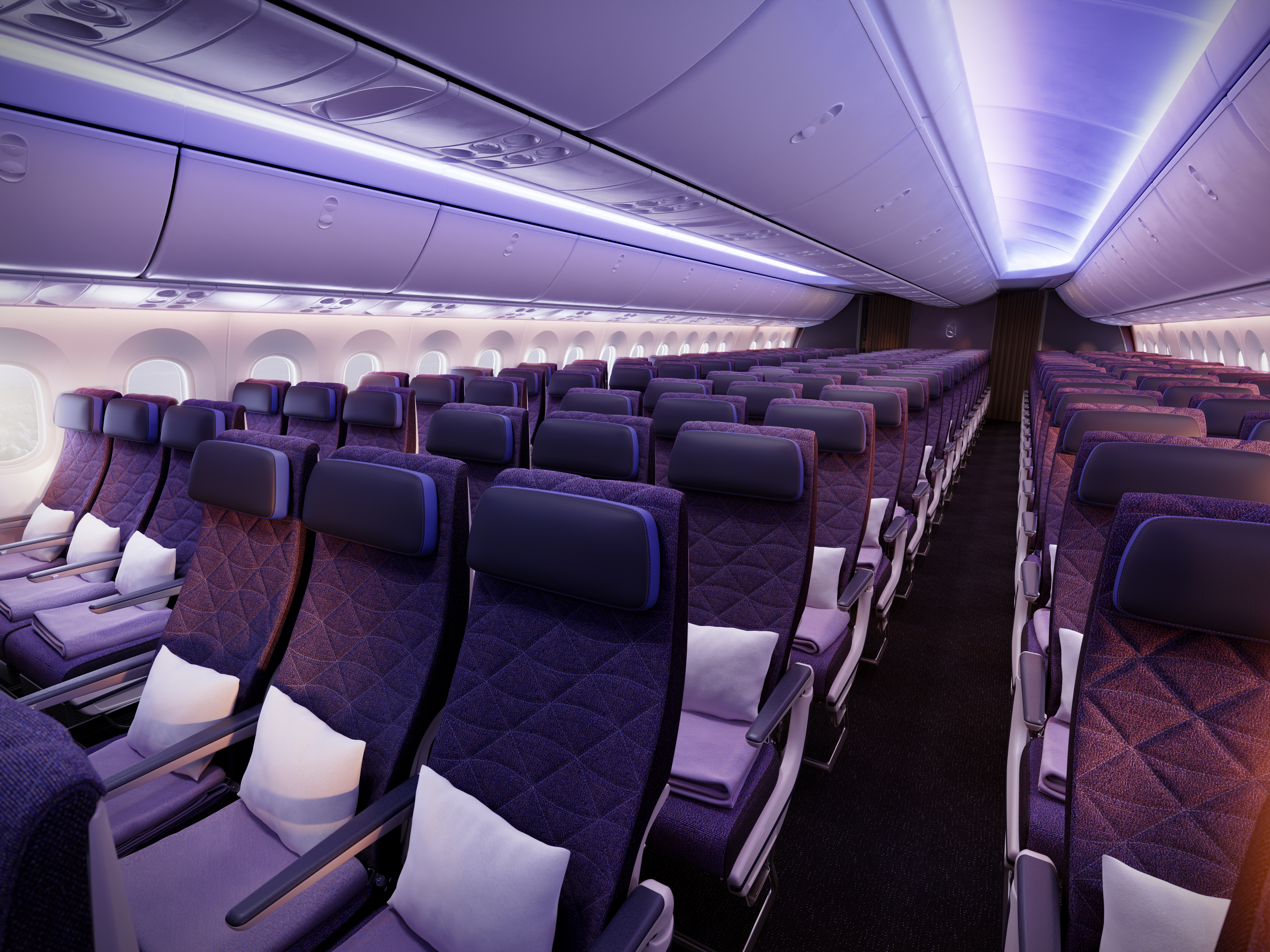
Credit: Riyadh Air
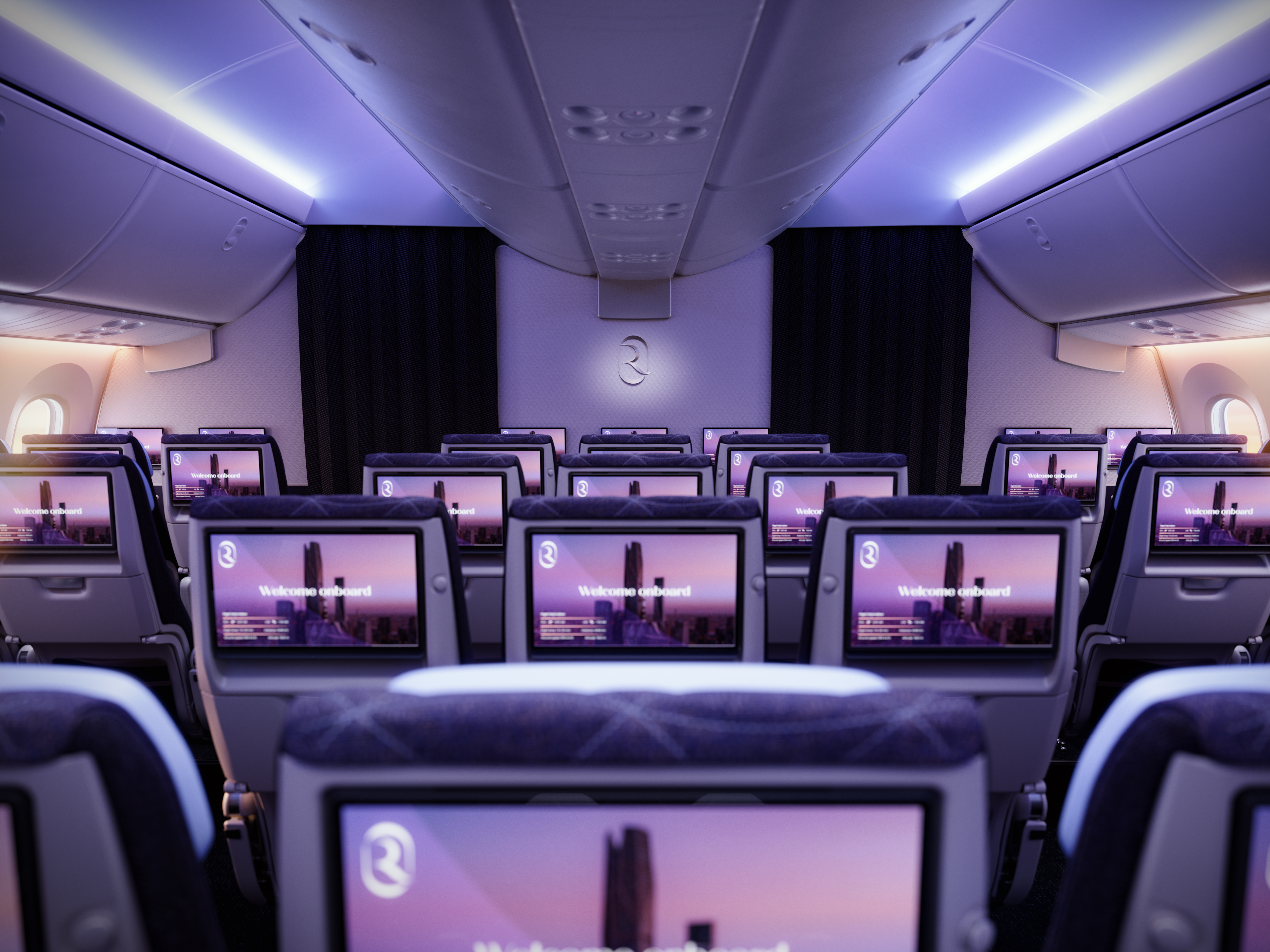
Credit: Riyadh Air
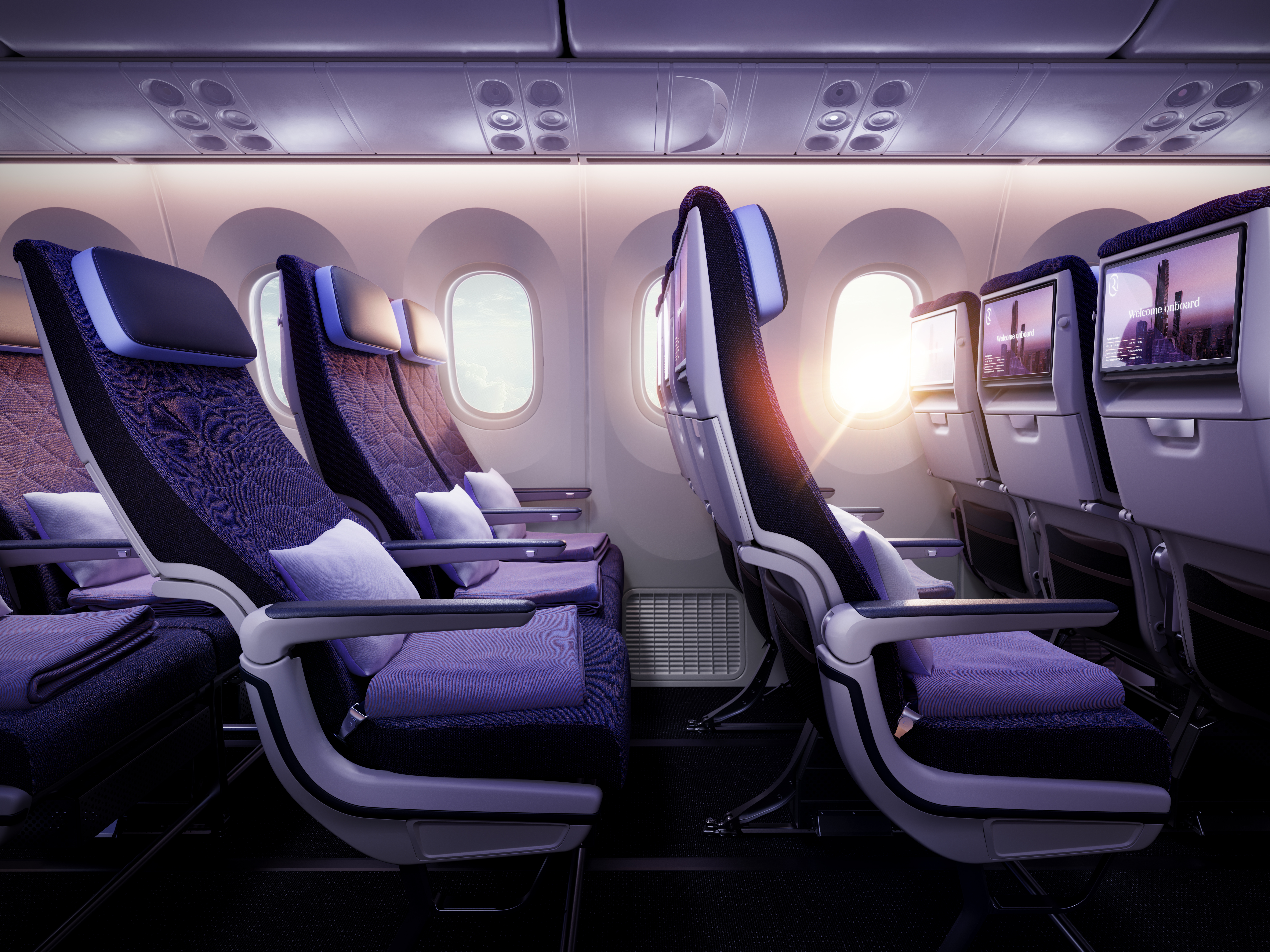
Credit: Riyadh Air
Wifi Will Be Free
Aircraft will feature ViaSat satellite wifi for gate to gate connectivity, and access will be free for Riyadh Air loyalty program members. The entertainment system will include Live TV.
What’s Next For Riyadh Air
Later this summer Riyadh Air will announce destinations and publish schedules and fares. There will be a separate revealing of amenity kits, pajamas, and other soft goods.
There will also be a future announcement about Riyadh Air first class, but that won’t come until closer to first delivery of a widebody aircraft order that has not yet been placed.
I Don’t Fully Understand Riyadh Air Yet
Riyadh Air does not plan to join a global alliance, but will partner with other airlines. They announced a Delta partnership last year and plans for a joint venture (as well as Delta flying to Saudi Arabia).
Riyadh Air has said they expect to focus on point-to-point traffic, not low yield connecting passengers. Saudia will remain the carrier cheap Hajj pilgrimages. Riyadh Air will be a super premium airline with attention to detail, and a brand meant to represent the country as the first impression they get of Saudi Arabia.
My sense for keeping these separate, rather than upgrading Saudia, is that one would offer a product representing traditional Muslim values while Riyadh Air might be more Western. There has been some sense that Saudi laws would be changed to allow Riyadh Air to serve alcohol onboard (and so domestic politics required a separate airline responsive to more religious conservatives). However, a spokesperson tells me “Alcohol not to be served as we follow the laws of the land, if that changes we will adapt accordingly.” The law hasn’t been changed yet.


Very interesting how that tv sound “technology” is supposed to work without headphones and with zero disturbance on neighboring passengers!
Secondly i really don’t see as fancy as it gets how they’ll compete without alcohol
This strikes me as a sort of Saudi version of the Emirates vs Etihad play.
Saudia’s primary revenues as an airline has very little to do with the Hajj pilgrims.
interesting that they are calling their product Business Elite. Apparently DL gave up rights to that name.
the whole alcohol thing will get resolved even if they don’t serve it within 30 minutes of being on the ground – but even that will change. Partner carriers including VS now and DL eventually will serve alcohol, just not over Saudi airspace.
and it isn’t worth chasing all of the Indian low fare connecting traffic as other Middle East carriers do
Meh. Until we figure out how to book them with points, I’ll leave them on the back burner for now.
And if Delta sticks their (premium) nose in Riyadh Air’s business model, you’ll probably pay 500K for a Riyadh business class seat.
All of the so-called “Indian low fare connecting traffic” is very important to the US3 & EU3 airline groups. Those who get a large share of that business end up in a stronger position than those who don’t.
Looks nice, but… of course, the major downside is having to fly through Saudi Arabia.
Unlike other ‘premium’ Gulf airlines (Qatar, Emirates, etc.), Riyadh Air, like Saudia and Egyptair, is a ‘dry’ airline. I’m not saying everyone ‘must’ drink alcohol, but it’s nice to have the option of ‘bubbles’ up-front, at least, if you’re going to call yourself ‘premium.’ And, supposedly, instead of joining one of the big-three alliances, they’ve opted for ‘bi-lateral’ agreements with other airlines. Lame.
@Tim Dunn — Speaking of Delta (which we often do), this ‘new’ Riyadh Air cabin reminds me of DeltaOne Suites but with different colors. Not sure it’s that revolutionary.
@1990 – this is a much better seat than the garbage Thompson Vantage XL
@Gary Leff — Oh my, how “much” is doing a lot of work there. I’m booked on JAL from JFK-HND in Business Class later this year, so I’ll get to try the Safran product first-hand soon and see whether it truly is “much” better it is than Delta’s Thompson Vantage XL. I’ve set high expectations… it’s JAL.
(By the way, if this is actual Gary, and not a mere impersonator, there is fun typo in this post–when referring to JAL, you wrote “A350-100s” and it should be “1000,” not “100,” though an ‘A350-100’ would be an interesting concept, assuming it’s a super-low capacity variant.)
The Maybach vs. Mercedes comparison is not bad, because both are indeed superior to most passenger vehicles, and neither are realistically ‘garbage,’ even if one may be ”more luxurious’ and ‘more expensive than the other. Actual ‘garbage,’ say a 2001 Pontiac Aztek equivalent, is Air India’s old Business Class on their 777s. Yikes. But, to compare Riyadh Air’s new Business Class to DeltaOne Suites on their a350s or United Polaris on its 787s or the ‘new’ AA Suites on their 787-9s (can’t wait to try that), yeah, they’re not all ‘that different’ for high-end Business Class. Like, I’d still put Qatar’s ‘Q-Suite’ and ANA’s ‘The Room’ above most else, for “Business” at least. And, I wish that Singapore (ugh, that angle) and Emirates (2-2-2, really?!) would upgrade their ‘Business’ seats. (I know, I know… Emirates has the ‘newer’ 1-2-1 on some aircraft.) There’s still a long way to go for truly ‘upgrade’ across the board, and until then, it’s going to be inconsistent, which is annoying when we book, pay for the newer product, only to experience a last-minute swap. Further, I doubt many airlines will have the incentive (or the financing) to do more or better if there’s a significant global economic downturn (which there appears to be, even if that means more ‘deals’ for some of us.) Anyway, there’s my rant.
@Tim Dunn:
“Isn’t worth chasing all of the Indian low fare connecting traffic”
Those “Indian low fare connecting traffic” have to pay a lot of money as well when they are flying back with their families during peak season. That’s 3-6 tickets they have to purchase (mom, dad, kids, parents/in-laws, etc.). They also keep the plane quite full during low season…unless you think it’s ok for QR to fly ATL-DOH 2x/weekly during “low season”.
India traffic connecting over the Middle East carriers is volume. It is the ULCC equivalent of flights to Florida. Doesn’t mean that carriers can’t revenue manage carrying enough of that traffic to fill planes while focusing on high yield traffic but Riyadh believes it is capable of carrying the higher yield traffic w/o binging on a bunch of low fare traffic. Using 787-9s means you don’t have to carry near as many passengers.
as for the Vantage XL as used by DL, it is now a ten year old concept since DL was one of the first airlines to creating a suite by putting doors on a business class seat. but it is hardly garbage.
Designs progress. and DL is reportedly considering a new seat on their 350-1000s. JAL’s design has only been in service for about a year
and let’s remember that AA is just now taking delivery of its first widebodies with suites while UA has yet to announce a new business class product. Polaris is also a decade old.
It’s the Indian/South Asian-related air passenger traffic that allowed Emirates, Etihad and Qatar to become what they are. And the way to make Riyadh Air work out more easily without being as heavily reliant upon de facto Saudi government subsidies? To make the airline work well for South Asian-related air passenger traffic.
The GCC3 airlines + Turkish + Air India are in for a real fight even as the growth in South Asian wealth and in a strategic desire to shift from China toward India will grow the market demand that can be served by these airlines and more. Those airlines already have a big leg up over Saudia and Riyadh Air, and time will tell if they are too late to the game and this turns out to be yet another expensive White Elephant gamble.
@Tim Dunn:
“India traffic connecting over the Middle East carriers is volume. It is the ULCC equivalent of flights to Florida.”
Have any proof of that?
sub $700 fares are common India to the US (RT) and those are ULCC levels. The ME3 carry large volumes of that traffic.
None of which changes that Riyadh is not getting into that business a) because they don’t intend to build the connectivity to India in order to carry that traffic and b) they, so far, are not using large widebodies like the 77W, A380 and 35K to justify carrying that kind of traffic.
and for all those that think that Riyadh can’t do what EK or other ME airlines have done forget where the Middle East was in its connections w/ the world just 30 years ago.
Saudi Arabia is a larger country with more citizens than most other countries.
and, yes, they have the same money that other ME countries used to develop their national airlines before turning them over to the free market.
“sub $700 fares are common India to the US (RT) and those are ULCC levels. The ME3 carry large volumes of that traffic.”
Without context, it doesn’t reveal too much.
I would also like to see some proof of “sub $700 fares are common India to the US (RT) “.
all it takes is a tad bit of research. 3 seconds on Google flights proves my point.
and what exactly is your point in arguing?
Riyadh isn’t pursuing that traffic.
Interesting. LALF just posted that the seat pitch is 45″ which is why it looks so tight and the lie flat reaches 70″. That’s a very notable difference.
@Tim I would love you to prove that sub-$700 fares to India are the norm. Crankyflier shared the daily US-India fare in Q2-Q3 2024 from the US including those carried via JV:
United: 382 passengers at $1,175
American: 350 passengers at $989
Emirates: 1,420 passengers at $984
British Airways: 482 passengers at $965
Lufthansa: 423 passengers at $960
Air India: 1,814 passengers at $909
Etihad: 711 passengers at $836
Delta: 373 passengers at $776
Qatar: 1,166 passengers at $746
If Riyadh Air’s business model is to completely reject the connecting South Asian traffic above, leave the Hajj traffic to Saudia, and solely compete for O&D to Saudi Arabia, then there’s little more that needs to be said. It will never become as large to compete vs a Qatar, Emirates, or Etihad. There’s nowhere near enough traffic (let alone high-paying premium traffic) to fill many planes to Riyadh out of all places especially on an airline that for now still cannot serve alcohol.
jeremy,
first, tell us again why it matters so much for you and others to argue about fares to India which Riyadh doesn’t intend to focus on ?
second, you clearly have no idea how the data you quoted – from CF – was generated or what it means.
Foreign carriers that are not in a JV do not have to release their fare data to the DOT. Foreign carriers in JVs w/ US airlines and US airlines have to release that data.
None of the ME3 are in a JV.
Coupon data might be seen if a carrier such as B6 provides a connecting leg to the gateway.
but the primary way is via GDS data and that does not include bookings directly w/ the carrier or other non-GDS sales platforms.
third, airlines revenue manage. There are sub $700 fares but that doesn’t mean airlines have to fill the plane with them.
@Tim Dunn
“(J)eremy,first, tell us again why it matters so much for you and others to argue about fares to India which Riyadh doesn’t intend to focus on ?”
Maybe because you brought it up in the first place?
“(A)nd it isn’t worth chasing all of the Indian low fare connecting traffic as other Middle East carriers do.”
Apropos, which routes and which dates are you referring to?
@Jacobin777 — I find it fascinating how a new Saudi airline can devolve into a debate over connecting Indian passenger traffic. A quick search today on Google Flights shows that Virgin Atlantic is offering $653/person for JFK-LHR-DEL, roundtrip, economy, for a 1-week trip in May (So, there, that’s less than $700.) Not bad. If you look ahead to the September, you can fly Air India, nonstop!, $705. Nice. Always nice to avoid those connections, if you can.
The real question is whether most Hindus would chose to route from our burgeoning-Christian theocracy through a hardline Islamic-theocracy. Besides, they aren’t likely to buy the ‘maybach’-level seats up-front (you know, since you were talking ‘economy’ for a family of 3-6 above.)
For those seeking affordable airfare between the US-India, you might consider connecting through Europe. However, be wary of that ‘stopover’ at CDG, AMS, FRA, HEL, etc., because, if you get stuck, due to a delay, cancellation, etc., there may be limited protections.
You might think that EU261 could help in those situations, like, to compensate you for your lost time, but no, since the Airhelp v. Austrian case (2022), the European Court of Justice explicitly excluded flights that originate outside the EU to outside the EU, considering the overall itinerary (not the affected segment), even if the connection is within the EU.
To me, that case was poorly decided, harming connecting passengers. If the airline is EU and the connection is in the EU, then the airline should pay people when they fail to properly maintain or staff their planes. Anyway, at least the EU has more protections that we do in the US currently. Airlines in the USA can practically treat you like cattle and there’s no recourse other than a partial refund, if that. We deserve better.
@1990:
May is a lower-season time. Prices tend to pick up substantially June-August and again in the winter.
A lot of Hindus work in both the USofA and Gulf Countries (not sure about Saudi though) however I don’t see it as a problem.
Regardless, we’ll see what Riyadh Air does.
Is there any guarantee that you’ll emerge in one piece from these ‘suites’?
@Tim Dunn uh no. Cranky mentioned the data is ARC / BSP which pulls from the IATA, not GDS. The DOT is not involved in this and no one ever claimed or discussed the ME3 carriers as being in a JV. The fact of the matter is the best quality and most comprehensive dataset we have that was shared by any source completely refutes your claim. You have no data to back any of your claims.
Regardless this discussion is about Riyadh Air – the ME3 rely on Indian connecting traffic to drive a big chunk of their business – most of their business is connecting traffic elsewhere as well. None rely on O&D like Riyadh Air is targeting to primarily drive their business. So the question is will Riyadh and Saudi Arabia be able to position itself as a more popular and desirable tourist and business destination than Dubai, Abu Dhabi, and Qatar by a few magnitudes to make this viable? Especially when the tourism investments and initial plans to date in Saudi Arabia are already being noted as performing far below expectations and are being scaled back?
Never say never, but I would not bet on Riyadh Air’s strategy at all.